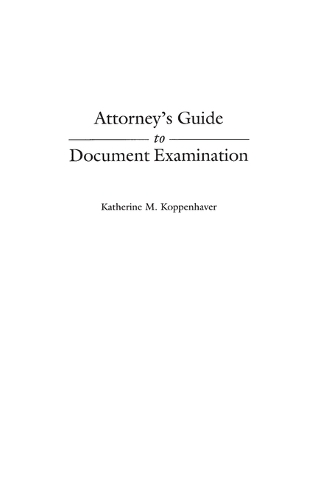
Attorney's Guide to Document Examination
(Hardback)
Publishing Details
Attorney's Guide to Document Examination
By (Author) Katherine Koppenhaver
Bloomsbury Publishing PLC
Praeger Publishers Inc
30th December 2001
United States
Classifications
Tertiary Education
Non Fiction
363.2565
Physical Properties
Hardback
288
Description
Attorneys must develop many skills in order to benefit fully from their collaborations with forensic document examiners in cases involving questioned documents. This comprehensive guide for attorneys provides a thorough grounding in how to prepare for court and deposition testimony. It also explains how to select appropriate comparison documents for forensic document examiners, the basic principles of handwriting identification (the knowledge of which enables lawyers to challenge incorrect statements), and what document examiners can and cannot determine based on the evidence. When the authenticity of a document is in question in the courtroom, forensic document examiners are brought in to determine such things as whether a signature has been forged, whether the document has been altered, and whether it is all things it purports to be. The examination of suspect documents generally involves comparison with examples of known genuine writing. Attorneys need to know how to select appropriate comparison documents for forensic document examiners. This is but one of the many skills that attorneys must develop in order to benefit fully from their collaborations with forensic document examiners, and it is explained here in detail. So, too, are the basic principles of handwriting identification, the knowledge of which enables lawyers to challenge incorrect statements. This comprehensive and thorough guide for attorneys also explains what document examiners can and cannot determine based on the evidence, and it provides a thorough grounding in how to prepare for court and deposition testimony. Among the many unique features of this attorney's guide is an extensive list of questions for lawyers to ask their own, and their opponent's, expert witnesses before going to trial. The deposition of a forensic document examiner includes questions relating to the examiner's experience, working methodology, background and education, knowledge base, certifications, achievements, and many other items relating to the examiner's abilities. Next, an extensive set of questions helps lawyers ask for the right information pertaining to the examiner's specific methods of preparation for the case at hand. After the deposition is taken, the expert must be qualified in court; this book includes 60 qualifying questions. After qualification, it is time to move on to questions about document examination and the case being litigated. Finally, new questions pertaining specifically to the cross-examination of document examiners are presented, once again relating to credentials and a given case. This valuable resource concludes with a chapter describing the relevance of various court citations involving handwriting. Appendices are devoted to suggested reading; a resource list of experts related to the field, including photographers, librarians, and appraisers; organizations; and a glossary of technical terms.
Reviews
"A must read....comprehensive, precise, well-formatted, and a great source of information for attorneys or anyone who actively participates in document examination or works with forgeries."-J. Lucas, Forensic Document Examiner
"All trial attorneys who may be confronted with procuring the services of a forensic document examiner or who may be cross-examining a forensic document examiner should have this text in their library. It is a comprehensive yet concise guide for the attorney who wants to be well-prepared and armed with the knowledge of the services and limitations of the field of forensic document examination."-Larry S. Miller Professor & Forensic Document Examiner, State of Tennessee
"In reviewing this book as an attorney, one will obtain a strong 'nut shell' approach to pursuing and/or defending cases involving handwriting. A logical step by step approach is provided and will arm the practitioner with a means of acquiring sufficient information to understand the intricacies of the 'written' word."-David J. Preller, Jr. Preller & Preller
"Katherine Koppenhaver is one of the premiere document examiners in the United States. Not only has she made numerous important contribitions through her tireless efforts to promote professional standards in the field, but she has also shared generously her expertise and advice when it was needed. The Attorney's Guide to Document Examiniation is the next logical step."-Sheila Lowe, Document Examiner author of Handwriting of the Famous & Infamous
"There are good teachers and even great teachers, but once in a while there are a few remarkable individuals who become legends in their own times leaving legacies of their written and spoken materials for those who follow in their footsteps. Kathy Koppenhaver is a living legend with an unquenchable thirst for knowledge and vast experiences that she generously shares with everyone she meets. She is a treasure to the field of document examination."-Ruth Holmes, CDE Bloomfield Hills, Michigan
"What is an expert witness What do they do Ms. Kathy Koppenhaver has answered those questions in a readable, concise, and educational book on the subject...a must read for the legal community."-Rita M. Lord, BCFE
"When attorneys contact me about a case, most often they will mention that this is their first time working with a document examiner or handwriting expert. I have long wished for a book that could acquaint attorneys with my work, and here it is. This book is a 'must read' for attorneys and paralegals. They will understand how to approach cases involving suspect documents, and the concepts discussed here may have broader application for them in working with experts in other fields."-Emily J. Will, Certified Document Examiner
Author Bio
KATHERINE M. KOPPENHAVER is a Certified Document Examiner and a Diplomate of the National Association of Document Examiners (NADE), of which she is currently president./e
